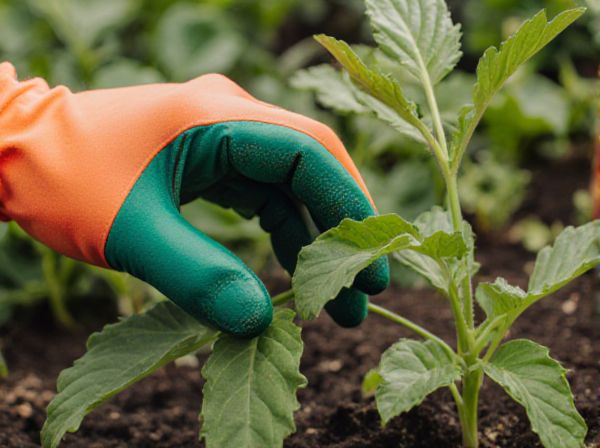
Growing degree days vs Calendar-based planting Illustration
Growing degree days (GDD) provide a more precise method for timing planting by measuring heat accumulation essential for crop development, unlike calendar-based planting which relies solely on fixed dates. This approach accounts for seasonal variations and temperature fluctuations, improving seed germination and growth outcomes. Farmers using GDD can optimize planting schedules to enhance yield potential and adapt to changing climate patterns effectively.
Table of Comparison
| Criterion | Growing Degree Days (GDD) | Calendar-Based Planting |
|---|---|---|
| Definition | Measures heat accumulation to predict plant development stages | Uses fixed calendar dates for planting schedules |
| Accuracy | High - adapts to actual temperature conditions | Low - disregards current temperature variations |
| Flexibility | Dynamic - varies yearly based on weather | Static - same planting dates every year |
| Optimal Usage | Regions with variable climate and temperatures | Regions with stable, predictable climate |
| Risk Management | Reduces frost and heat stress risks by timing planting to heat units | Higher risk of planting during adverse weather conditions |
| Crop Development Prediction | Improved forecasting of growth stages and harvest dates | Based solely on historical averages, less responsive to anomalies |
Understanding Growing Degree Days in Gardening
Growing Degree Days (GDD) provide a precise measurement of heat accumulation essential for predicting plant development stages, enhancing the timing of planting and harvesting. Unlike calendar-based planting, which relies solely on fixed dates, GDD accounts for local temperature variations, optimizing crop growth and yield. This temperature-driven approach helps gardeners make informed decisions tailored to specific microclimates, increasing the success rate of seasonal crops.
Calendar-Based Planting: An Overview
Calendar-based planting relies on fixed dates to schedule planting activities, simplifying farm management by providing consistent timelines regardless of weather variations. This method is widely used due to its predictability, but it often overlooks microclimatic changes and soil temperature fluctuations that can impact seed germination and crop development. Understanding local climate patterns and historical frost dates improves the effectiveness of calendar-based planting by aligning sowing periods with optimal growing conditions.
How Growing Degree Days Predict Plant Development
Growing Degree Days (GDD) provide a precise measure of heat accumulation crucial for predicting plant development stages compared to calendar-based planting methods. By tracking cumulative temperature units above a base threshold, GDD models align planting schedules and growth forecasts with actual thermal time required by plants. This approach enhances crop management decisions and optimizes harvest timing, improving yield consistency and resource use efficiency.
Limitations of Calendar-Based Planting Schedules
Calendar-based planting schedules often fail to account for the variability in temperature and microclimates, leading to suboptimal planting times that can reduce crop yields. Growing degree days (GDD) provide a more precise measure by accumulating heat units required for crop development, improving accuracy in predicting phenological stages. Reliance on fixed calendar dates ignores environmental fluctuations, resulting in missed opportunities for optimized growth and increased vulnerability to climate change impacts.
Comparing Growing Degree Days and Calendar-Based Methods
Growing Degree Days (GDD) provide a precise measurement of heat accumulation, enabling more accurate prediction of plant development stages compared to calendar-based planting, which relies solely on fixed dates regardless of temperature variations. GDD-based planting adjusts to yearly climatic fluctuations, optimizing planting schedules to enhance crop yield and stress resistance. In contrast, calendar-based methods may result in mismatched planting times due to their inability to account for variable thermal conditions, potentially reducing crop performance.
Adapting to Climate Variability with Growing Degree Days
Growing degree days (GDD) provide a precise measure of heat accumulation essential for crop development, enabling farmers to optimize planting schedules beyond traditional calendar-based methods. This approach adapts planting dates to actual thermal conditions, reducing risks associated with climate variability and improving yield predictability. Utilizing GDD enhances decision-making by aligning crop growth stages with favorable environmental conditions, supporting resilience in fluctuating climates.
Best Practices for Using Growing Degree Days in Your Garden
Growing degree days (GDD) provide a precise method to track heat accumulation, helping gardeners predict optimal planting and harvest times better than traditional calendar-based schedules. Using GDD enables customization for specific crop growth rates and local climate variability, improving yield and reducing risk from unpredictable weather conditions. Integrating GDD monitoring tools with soil temperature and local weather data ensures timely interventions, maximizing plant health and garden productivity.
Transitioning from Calendar to Degree Day Planting
Transitioning from calendar-based planting to growing degree days (GDD) enhances precision in crop scheduling by tracking accumulated heat units critical for plant development. Utilizing GDD allows farmers to align planting dates with optimal soil and air temperatures, improving germination rates and yield consistency. This data-driven approach reduces risks associated with variable seasonal weather patterns and increases agricultural efficiency.
Tools and Resources for Calculating Growing Degree Days
Growing degree days (GDD) tools and resources provide precise data crucial for optimizing planting schedules by calculating heat accumulation tailored to crop development stages. Advanced GDD calculators integrate weather station data, historical climate models, and customizable base temperatures, enhancing predictive accuracy over traditional calendar-based planting methods. Utilizing platforms like the USDA's Crop Data Layer or specialized apps such as Growing Degree Days Calculator ensures farmers make data-driven decisions to increase yield and reduce risks associated with early or late planting.
Maximizing Yields: Choosing the Right Planting Strategy
Maximizing crop yields depends on selecting the optimal planting strategy, with Growing Degree Days (GDD) offering a more precise method by measuring heat accumulation critical for plant development. Unlike calendar-based planting, which follows fixed dates, GDD allows farmers to align planting with specific temperature-driven growth stages, improving germination rates and overall crop performance. Utilizing GDD data enhances decision-making for planting time, ultimately leading to higher productivity and efficient resource use.
Growing degree days vs Calendar-based planting Infographic

 gardendif.com
gardendif.com